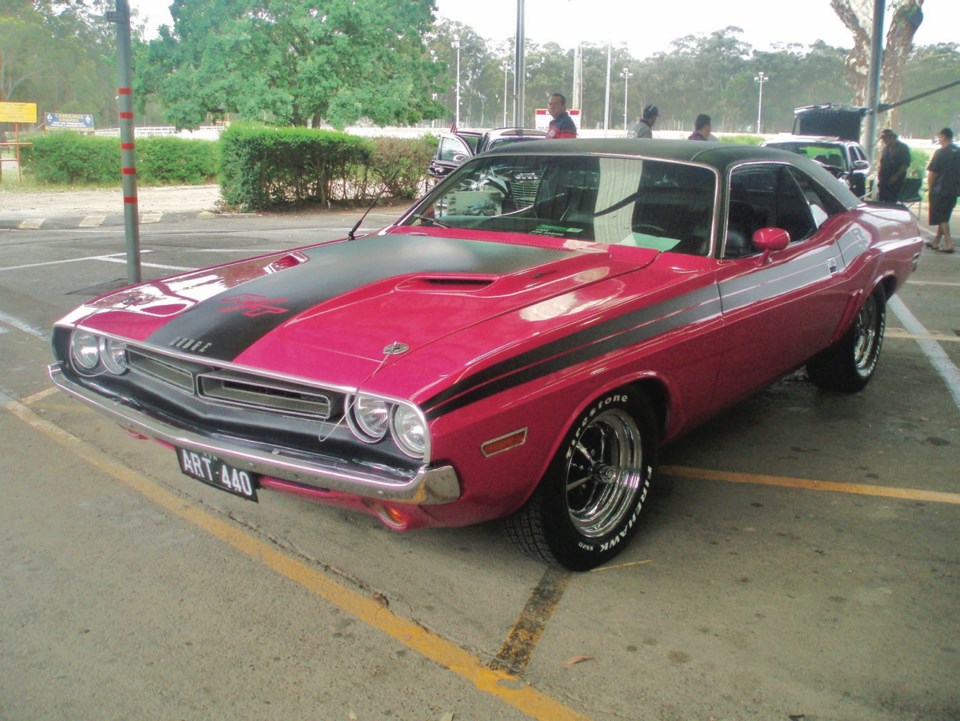Chrysler Corp. (now Fiat Chrysler Automobiles) liked the Challenger name so much it used it on four distinctly different cars in different eras. First was a full-size limited edition1958-59 Dodge Silver Challenger. Next was our subject, the 1970-74 Dodge Challenger pony car, a class initiated by the 1965 Ford Mustang.
After the pony car came the 1978-83 Mitsubishi-based Dodge Challenger subcompact. Finally, the current Dodge Challenger arrived in 2008.
The 1970 Challenger pony car had the characteristic long-hood, short-deck, sporty-car profile. But since it was launched as a 1970 model, it was almost too late because the bloom was about to go off the pony-car market.
The Challenger was fairly large for the class, although not quite as big as the Mercury Cougar which was seen as its main competitor. The Challenger was 4,859 mm long and 1,933 mm wide, with a 2,794 mm wheelbase. It stood a svelte 1,285 mm high.
Engines ranged from the base “cooker” 3.7-litre slant six to a 7.2-litre V-8. Really dedicated performance buffs opted for the 7.0-litre 425-horsepower “Hemi” V-8 with twin four-barrel carburetors.
Power went to the rear wheels through an all-synchromesh, floor-shift, three- or four-speed manual transmission, or optional three-speed “Torqueflite” automatic.
Underpinnings of the unit construction Challenger were the usual Chrysler Corp. fare, with longitudinal front torsion bars and solid rear axle on leaf springs.
Car Life (December 1969) recorded the Challenger's performance in its test of an R/T (Road/Track) version with a 7.2-litre V-8 with four-speed manual. It reported zero to 97 kilometres per hour in 7.1 seconds and a top speed of 206 km/h.
Styling was clean and attractive with quad headlamps and a full-length accent crease that kicked up over the rear wheels for an elegant touch. In keeping with Dodge’s performance image, its ample beam and low silhouette gave it a wide, squat, purposeful stance, making competitors look tall and narrow beside the Challenger’s well proportioned handsome lines.
To stimulate interest among young buyers, the Challenger offered such “high impact” colours as Top Banana, Sub Lime, Go Mango, Plum Crazy and Hemi Orange.
The two-door Challenger came as a convertible and hardtop in two series: regular and R/T with such upgrades as a 6.3 litre Magnum V-8, stiffer suspension and heavy duty brakes.
A mid-year limited production addition, the Challenger T/A, named after the popular Trans-Am Pony Car road racing series, featured a more aggressive look and such goodies as a 5.5-litre V-8 with three two-barrels, bigger tires and a lift-off fibreglass hood sporting an impressive scoop. The T/A was discontinued after the 1970 model year.
As expected, the Challenger, with a big V-8, had stunning performance. Car Life (December 1969) tested a convertible with the 390 horsepower 7.2-litre V-8 with three two-barrels. It sprinted to 97 km/h in 7.3 seconds and reached 206 km/h. Being a convertible it was heavy at 1,769 kilograms. A closed car would have been even faster.
The Challenger was carried over into 1971 with few appearance changes, but quoted power was down due to the change from SAE (Society of Automotive Engineers) gross horsepower to the more realistic SAE net ratings. The 6.3-litre Magnum V-8 went from a 1970 rating of 335 horsepower to a 1971 figure of 250.
By the time the Challenger arrived, spiralling insurance rates for high-powered cars were affecting pony car sales. And tighter emission requirements and safety standards were reducing performance.
These factors, plus the arrival of a stunningly restyled mid-1970 Chevrolet Camaro, saw Challenger sales plunge from more than 83,000 1970s to fewer than 30,000 1971s.
The 1972 Challenger was redesigned, but the convertible was gone. The only offerings were the standard two-door and the Rallye in place of the R/T. Engine options were down too, with the largest V-8 now the 5.6 litre. Sales shrank to fewer than 27,000.
With compression ratios reduced to accommodate the unleaded gasoline required by catalytic converters, power dropped so much that the slant six was discontinued in 1973.
Sales recovered to more than 32,000 1973s, but after only selling 16,000 of the unchanged ’74s Chrysler discontinued the Challenger. While a worthy entrant, it had arrived a little too late to fully cash in the pony-car flurry of the 1960s.
The name lay dormant until 2008, when the current Challenger was introduced, culminating in the 707-horsepower SRT Hellcat, a real muscle car. It sprinted to 100 km/h in 3.6 seconds.
This new Challenger is, of course, cleaner, more powerful and more economical than the original Challenger pony car. But many enthusiasts still consider it the “real thing.”



